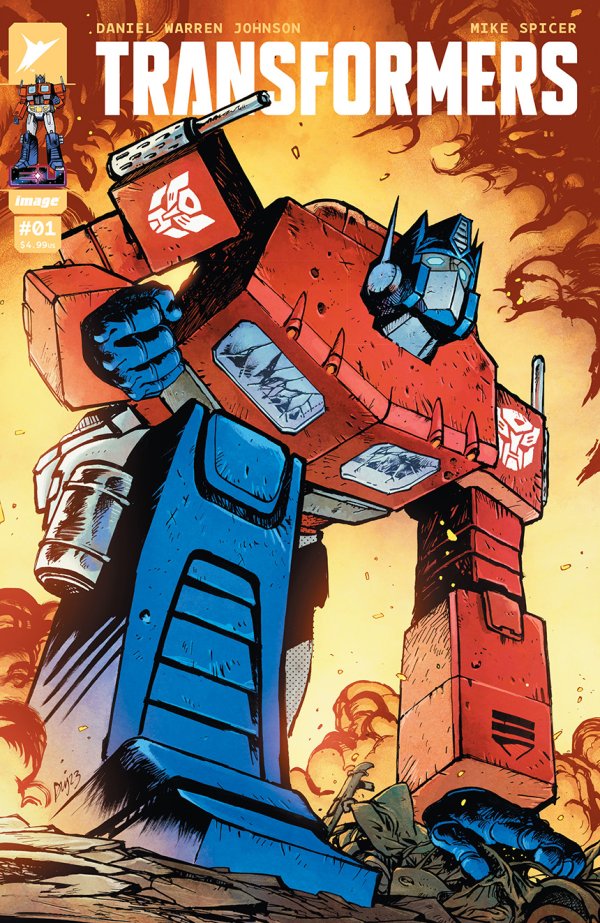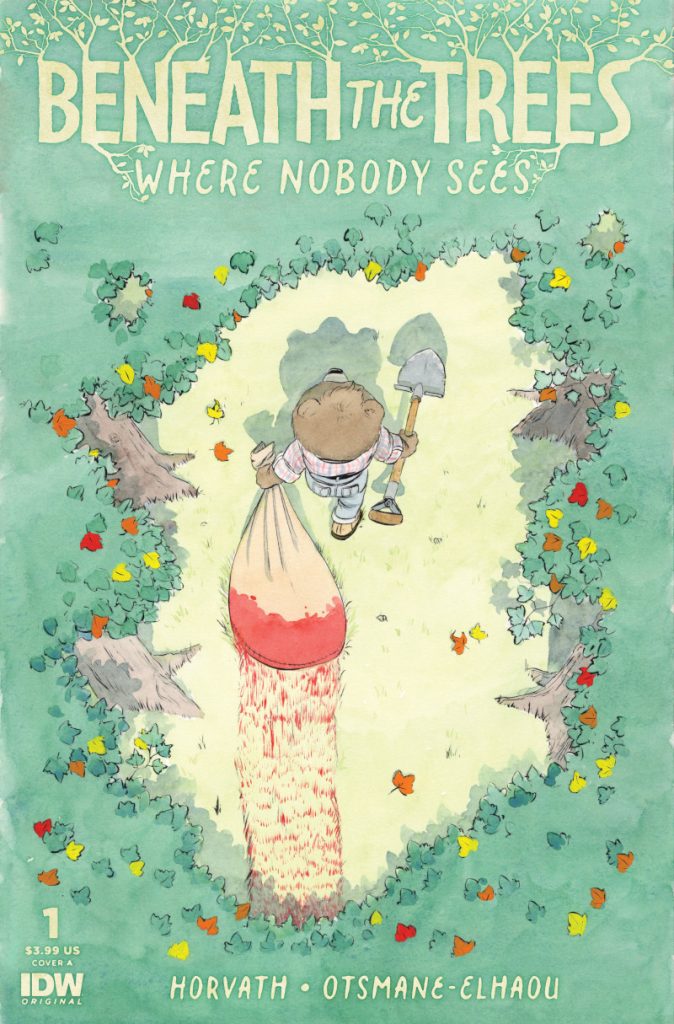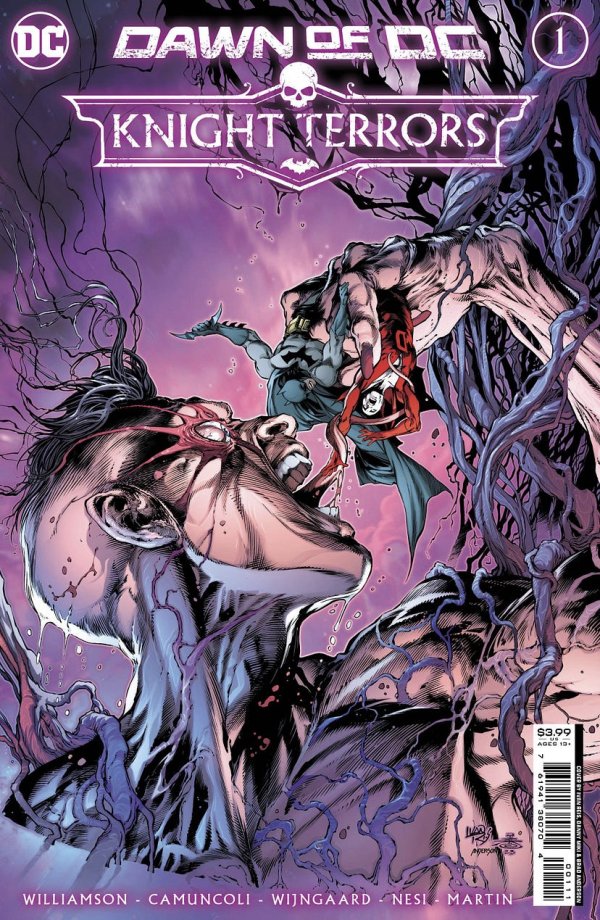“Completely Great, a Total Pain in the Ass, and Everything In-Between”: Retailers Discuss a Year of Change in Comic Shops
One of the constants throughout the history of SKTCHD have been my bi-annual comic shop check-ins, articles that explore the state of the direct market 1 from the perspective of the retailers themselves. These are amongst my favorite pieces to do, and for good reason. I love getting insight into this world, and to bask in the knowledge these retailers bring to the table. Despite my typical fondness for this piece, though, a new feeling had taken hold as the 2023 in Review feature neared.
For the first time, I was genuinely trepidatious about what I might learn from shops.
That was for two main reasons. One was how July’s retailer feature turned out, with exhausted shops admitting just how discouraged they really were, which created real questions about what might happen throughout the rest of the year. The other was even more crucial. It was how the conversation surrounding the direct market environment had shifted, with it being as toxic and public as I can remember it, and how that had cast a pall over everything in the space. Because of that, I was nervous about what I’d find when I quizzed retailers. Until you go down that path, anything is possible. It could have been a resurgence. Maybe it was a nightmarish turn for the worse. I wouldn’t know until I asked.
The reality is, 2023 landed somewhere in the middle of those two poles. Amongst those I talked to, the latter half of the year didn’t fix their woes, nor did it prove to be as catastrophic as it may have seemed. It was more of a mixed bag. Its uneven nature may have been best summarized by Eitan Manhoff, the owner of Oakland’s Cape & Cowl Comics, 2 who said “2023 was completely great, a total pain in the ass, and everything in-between.”
That may not be a surprise. It was clearly a topsy turvy year, seemingly offering an extreme version of the idea that comics retail slumps in the first half of the year before the second — but most notably the holiday season — comes to the rescue. And perhaps because of that stronger finish, the overall sentiment from shops seemed to be incrementally more positive than it was in July.
No one was jumping for joy, of course. It was still a challenging year! Issues did not magically resolve themselves! Processes still need to be fixed! But the vibes shifted ever so slightly to the point that a cautious optimism may have taken hold, at least for some. We’ll be digging into all that, as retailers share feedback on the year that was, what they’re seeing in their shops, and how they’re feeling as we head into the new year.
Before we do, though, here’s an important caveat. While I try to feature a mix of shops, talking to ones that offer a range of scale, geographic location, approach, experience, and everything else, this is just a small cross section of stores in a market comprised of a couple thousand of them. It is almost certain that some did far worse than those I talked to. Others may have done much better. Each shop represents itself and no one else. It’s like retailer Ryan Higgins from Sunnyvale, California’s Comics Conspiracy told me: “I’ve always liked the saying, ‘There’s not a comic industry, there’s like 2,500 comic industries.’
“Every store is its own, special world.”
This look into the year in comics retail isn’t meant to be a representative sample of the entire direct market. All we can do is get a sense of what some shops are experiencing, and how they view the whole from their vantage points. So, that’s what we’ll be doing today.
To say the past few years have been a time of change and unprecedented experiences for comic shops 3 is an understatement. Between 2020 and 2022, we saw the almost expected demise of the direct market, a completely unexpected boom fueled by the pandemic, an influx of speculators and collectors, constant changes in distribution, and more. That stretch was important, with shops making internal tweaks to processes at the same time. But it was also a bit of an aberration, a period where the direct market became something else for a time. That’s why shops weren’t just asked about 2023 in comparison to 2022, but also 2019, the last pre-pandemic year.
And much of the response fit into a category I’d label as “(blank)…but!” It was rarely just, “We were up” or “We were down.” It was one of those, but with something else to it, an element that helps contextualize their experiences. The best example of that comes from the shops that were down this year. The majority of those I talked to were. But most expected this after the dazzling highs of 2021 and 2022. As Higgins — whose shop was down 11% from 2022 but up over 40% from 2019 — said, “If you didn’t see this coming, you weren’t paying attention.”
“With everything opening back up post-pandemic in mid-2022, sales started to slip in the back half of 2022,” he added. “It was clear 2023 was going to be a huge correction for the industry.”
Higgins shared that most of his shop’s decline came from the dissipating speculator market, as new key issues 4 and variant covers “tanked” in 2023. While losses aren’t ideal, it’s a trend he was largely fine with.
“At least for us, the main cover A of ongoing comics stayed strong,” Higgins added. “We’re back to readers, which is an okay thing.”
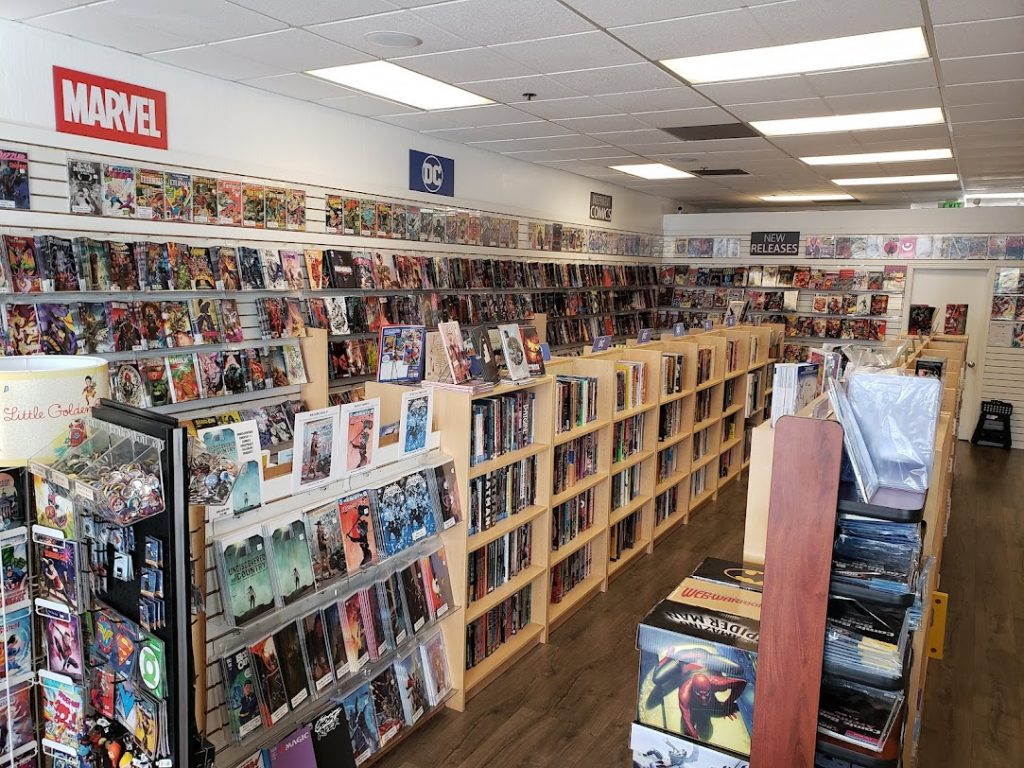
Other echoed Higgins, including Christina Merkler from the online comics retailer Discount Comic Book Service, or DCBS. While DCBS was down this year, 5 Merkler “knew there would be a leveling off,” especially with the entire retail sector struggling. Jenn Haines expected a dip as well, but for a different reason. She closed one of her three The Dragon stores in Guelph, Ontario in August 2022, 6 meaning she had one fewer source of revenue this year. Despite that massive change, The Dragon was only down 4.84% in 2023. Even more impressive was how it compared to 2019. Haines said that The Dragon’s revenues this year from two stores were 2.27% higher than 2019’s with three, which is a remarkable feat.
“This all tells me that sales are fantastic at The Dragon!” Haines told me. “Overall, I’m very happy with how 2023 turned out for us, although it definitely kept me on my toes!”
Aaron Trites said his shop, San Diego’s Now or Never Comics, was down in 2023, dropping 15% on the year, with both foot traffic and average customer spend decreasing by 10%. If you’re just reading those numbers, you might see that as a tough year. But Trites had a healthy perspective on it, if only because of how far his shop has come since it opened in 2019.
“Looking at it year to year, 2023 was a pretty bitter pill to swallow,” Trites said. “But in the context of the five years that we’ve been open, sales are almost right on target for our projected growth.”
“It was still our second-best sales year, by far.”
Not every down came with a but, though. While Patrick Brower from Chicago’s Challengers Comics + Conversation and Manhoff both emphasized they were up double digits since 2019 — “a mind-boggling 39%!” for Cape and Cowl — 2023 was still painful. Challengers was down 4.1%, with the month of March accounting for much of the drop. Cape and Cowl slipped even further at 9%. 2022 may have been Manhoff’s best year, but as the retailer emphasized, “9% is not a negligible amount of actual money, and the number of transactions it takes to account for that amount of money is kind of staggering when most of what you sell (costs) $4 to $20.” Drops are drops, and they still hurt, especially with rising costs surrounding them.
Others were up, even if they came with caveats as well. Bruno Batista of Dublin’s Big Bang Comics told me that 2023 was a “long slog of a year,” with a Christmas surge leading to the shop being up by the “smallest increment ever.” Brandon Schatz from Edmonton’s Variant Edition Graphic Novels + Comics saw its gross sales dip by 2% but its profits rise by 14%. Steve Anderson from Maryland and Virginia’s Third Eye Comics said 2023 was “slightly up,” but emphasized that it was “very close to even” with 2022. There were up years, but most of them were slight and came with addendums.
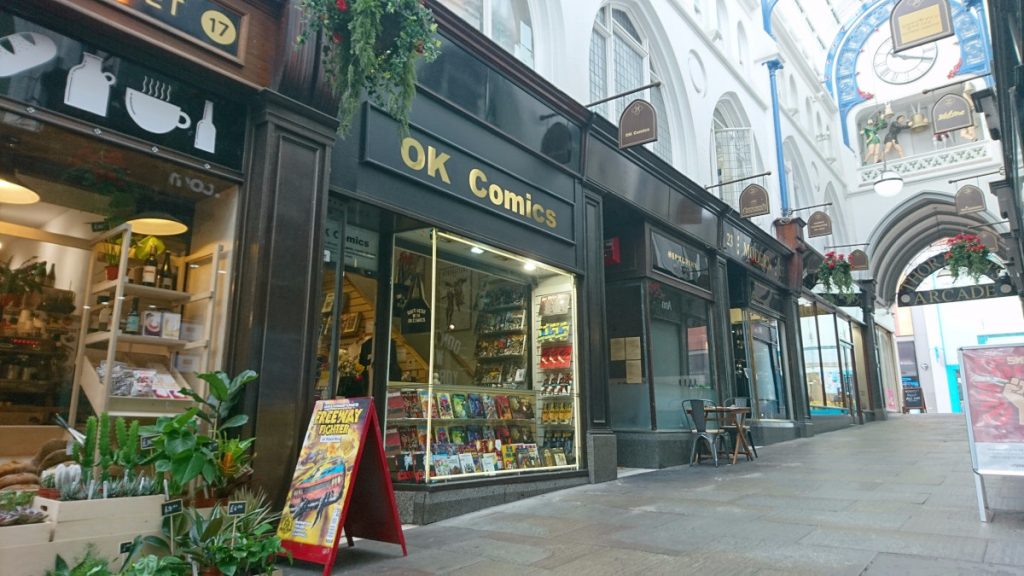
There was another class of response, ones that weren’t definitively up or down. Those belonged to a couple shops dealing with changes related to how the world has shifted the past few years. Jared Myland’s OK Comics in Leeds celebrated its 20th anniversary this year, something that was a lovely experience for his team and its community. But this United Kingdom-based retailer continues to face a challenge many retail stores in the heart of a city have been up against.
“It’s been a tough year adjusting to our customers new shopping habits and routines,” Myland said. “So many of our regular customers don’t work near our city center location anymore and reaching them is a constant hustle.”
Jen King’s Oak Ridge North, Texas-based Space Cadets Collection Collection was facing its own potential hardships related to its location in 2024. It was on a road “that was getting ready for some very significant construction with an end date that was unknown,” something that would surely drive away constant and casual customers alike. But with the economy impacting the store and its lease being up, King elected to move at the end of the year, a strategic decision that promises lower overhead costs and a space with “tons more traffic.” If the year was anything for King, it was a transitional one.
That was a common tale overall.
Speaking of commonalities, one from July was how shops lacked a big seller, a dynamite single-issue series that generated excitement for their customers. There were titles that did solidly enough. But some retailers believed the smash hits they desperately need may have become a thing of the past. Thankfully, the latter half of the year proved that to be untrue, if those I talked to are any proof.
“The Energon Universe? More like the €nergon Univ€r$€, amirite?!” Batista said.
“Transformers launched huge and is selling over 10x what the IDW books were,” Brower added.
“Transformers #1 became our best-selling single issue ever!” Trites told me.
That’s Daniel Warren Johnson and Mike Spicer’s Transformers series and the burgeoning Energon Universe at Skybound, an effort that launched with Robert Kirkman and Lorenzo De Felici’s Void Rivals in 2023. Merkler described that universe as “the perfect vehicle to bring new readers into shops,” adding that “the level of talent involved will only continue drawing them back in.” Every participating shop raved about the impact it had, offering a perfect blend of a smart marketing plan and inspired creative choices that led to a massive success.
The Energon Universe is the biggest story of what worked in comic shops in 2023. It wasn’t just something Skybound announced and then hoped for the best on. The publisher cultivated excitement and built a hit as much as anything, collaborating with retailers as partners in the process. While not every publisher has a creator as hot as Johnson is or a property like Transformers to build from, it seems as if there’s a lesson to be learned from the Energon Universe’s success in the direct market so far.
Outside of that, though, what worked for shops in 2023 was all over the place. Most efforts proved to be marvels of inconsistency. Case in point. I specifically asked retailers about an array of big swings in the latter half of the year 7 to see what connected. Save for the Energon Universe, there was massive variance in how they sold. Each had at least one shop that did well (or better) with the release and at least one where it just didn’t work.
It’s sometimes even broader than that. Trites said new single-issue comics fell off in a major way at Now or Never Comics, with back issue sales surpassing new comics in 2023. But then you have Challengers, where single issues were up across the board this year, per Brower. Sometimes, what works and what doesn’t is a big shrug, unless you’re a monster seller like the Energon Universe.
Some releases earned consistent mentions, though. Patrick Horvath’s IDW series Beneath the Trees Where Nobody Sees may have been the sleeper hit of the year. Merkler told me it was “one of the first titles in years to start out with normal numbers at #1, drop the normal at #2, then increase for #3, then increase again to #4 to numbers over #1.” It grew thanks to positive word of mouth, generating greater traction with each passing issue in some shops.
DC’s Dawn of DC initiative had plenty of fans as well, even if everyone was incredibly frustrated by how the publisher’s event Knight Terrors — which replaced the entire line two months in — nuked its momentum almost immediately. Customers responded to the back-to-basics simplicity of these superhero stories, with Shazam, Superman, and Birds of Prey being standouts.
Several shops reported that customers are following creators more than characters or titles these days. Names like Daniel Warren Johnson, Ed Brubaker and Sean Phillips, James Tynion IV, Zoe Thorogood, and others consistently moved the needle. Myland said his shop’s best-selling titles tend to be creator focused. That was a common refrain amongst his peers as well.
This ties into something Anderson’s been saying for a while. His belief is that comics are headed towards a more “content/creator-driven” approach after its time as a collector-driven market. Anderson described this trend as a “huge positive” and “the best market to sell comics/graphic novels in,” which customers seem to agree with. Many of the shops I talked to saw that play out this year.
Interestingly, another creator who proved to be a lightning bolt doesn’t even work in comics. It was James Gunn. The CEO of DC Studios revealed the next wave of its movies and generated heat for some shops in the process, with Trites describing that announcement as “maybe the single most effective bit of marketing in 2023.” It led to a surge of interest in collections like All-Star Superman and Supergirl: Woman of Tomorrow. While Gunn’s Midas touch famously resulted in big sales on Amazon, comic shops reaped the benefits as well.
Adaptations were a solid driver of customers to shops overall. Whether it was varying anime or live-action takes on manga titles or Spider-Man: Across the Spider-Verse further cementing Miles Morales as a comic shop superstar, retailers saw gains thanks to an array of movie and TV releases, mostly on collections featuring these characters and stories.
That leads to another trend in 2023. Some reported a growing lean towards trades and graphic novels. Trites said those were his “most consistent category sales-wise,” resulting in Now or Never expanding its trade inventory by 15%. Myland reported that customers were increasingly talking about “switching to trades,” with the belief that comics are “now written to be read as a whole” fueling that. It helps that there’s a perception that you get more bang for your buck that way. Would customers rather spend $10 on a single issue or on a trade paperback? The answer increasingly appears to be the latter, and that those customers are less price resistant than single-issue readers.
Top sellers for trades and graphic novels fit the creator-centric lean, with Daniel Warren Johnson’s Do a Powerbomb hitting big and Ed Brubaker and Sean Phillips acting as maybe the surest shot in comics. But others that don’t match that focus thrived as well. TMNT: The Last Ronin is a great example of that. Its collection has proven to be a rare evergreen seller for shops, even topping the charts for at least one store.
Naturally, kids’ books and manga were a big part of the graphic novel story. Manga continues to pile up sales, particularly headliners like One Piece, Spy x Family, and Blue Lock. King said her top sellers were “graphic novels, manga, and kids’ books,” with the retailer emphasizing that her list largely reflected what 2022’s BookScan numbers showed. Schatz noted that Variant Edition has cultivated an audience for its all-ages section by hosting launch events for new Dog Man releases and participating in “an increasing amount of school book fairs.” Those efforts have created greater awareness in the shop and an increase in foot traffic along with it.
Directly engaging with current and potential customers like Schatz mentioned is immensely valuable for shops these days. That’s at least in part because of the staggering number of comics and graphic novels being produced today. It can be difficult to find potential favorites from the sea of releases. While shops have always emphasized handselling, most have found that offering guidance to customers has become increasingly important.
Myland and Manhoff have both seen staff recommendations create hits in their stores. A push from your team can turn an unknown book into a small hit or even a “consistent seller to a monster success,” according to Manhoff. It requires work, and can be inconsistent in its impact. But when handselling works, it works wonders.
“At points it’s felt like we were actually bullying folks into buying Do a Powerbomb, but so many people came back asking ‘How did you know I’d love that book so much?’” Myland added.
That’s important both in-person and online, as Merkler learned. While DCBS doesn’t have a storefront, they created their own version of direct engagement this year. Merkler said DCBS’ “biggest success in 2023 was that each time we sent a six-to-eight-page preview to our customers after our initial orders were received, we saw a 20 to 30% increase in orders for those titles.” That’s massive, and indicative of just how crucial this type of activity is for shops.
The essential nature of direct customer engagement is at least in part necessary because of the tough time publishers are having in marketing comics. The view by some is that broader promotion of comics simply does not exist, at least not in a way that benefits shops. Higgins described marketing as “the single biggest problem for comics, and it’s only going to get worse” as social media and comic-related outlets disintegrate.
While everyone understands that resources are limited and that decisions made outside of everyone’s control 8 contribute to the problem, retailers like Anderson believe that “the constant churn of solicit, hype, next solicit, hype, turned comics into something that is counter-intuitive to comic-selling.” That just isn’t effectively guiding readers to comics anymore. That’s why the success of the Energon Universe stood out as much as it did. Skybound took a novel approach to the marketing side and saw big wins as a result.
While marketing is a major issue, the comic-specific pain points retailers reported didn’t feel as severe as they did in July, at least amongst those I talked to. That may relate to these shops getting a bit more conservative. One way that manifested itself was in subscriber management. Some are putting a cap on how long they order comics without the customer buying them. Too many were burned by people deciding they no longer wanted what was in their pull boxes after ghosting shops for months. Those restrictions protected shops and led to gains for Higgins, who said “putting a hard 30-day limit on subscribers has actually resulted in them coming in more often and buying more comics.”
“So, win-win all around!” the retailer shared.
Another way this showed up was in how some pared back what they’re ordering. This strategy insulated shops from being burned by underperforming launches and unsold inventory, something King leaned into this year.
“We have had so many book series that launched to disappointing rack sales numbers in the last year that we ordered conservatively with the goal to sell out. We did,” King told me. “I know most companies do reprints to cover the readership, and we have re-ordered where we have needed to.
“It meant we have missed out on maybe some hot book sales, but also we didn’t overspend on books that didn’t catch fire.”
With hits proving rare and the shelf life of single issues dwindling, this sort of risk averse approach is a prudent one. That said, while it’s smart business for retailers, it will have a serious impact on the overall market if they aren’t incentivized to reverse this trend. And it isn’t just smaller publishers on the chopping block either. The Big Two are struggling to consistently attract readers as well. Even the mighty Batman is under fire, and for a variety of reasons.
“Batman would be an unexpected example for something that hasn’t been connecting with readers lately. The core Batman title remains a best seller, but sales for almost any Bat minis or spinoffs are down,” Trites said. “Part of that is Batman fatigue, and part of that is pricing, but when Batman facsimile reprints and classic Batman trade paperbacks are regularly outselling new Batman releases, that’s speaks more to the lack of interest in current Batman rather than a lack of interest in Batman overall.”
That relates to something that connects much of what didn’t work this year. There is a perception that many titles don’t have an audience or a reason to exist. That’s affecting titles of all varieties, even previous locks like Big Two events. It seems as if there’s a growing belief amongst customers that superhero events just happen, proving to be inessential rather than milestones for these universes. While Knight Terrors generated the most ire — I cannot stress to you how disliked Knight Terrors really was — it seems as if very little Marvel or DC is doing on this front is working.
But that issue extends to all parts of the Big Two, as the constant churn and burn of mini-series — particularly at Marvel — and endless new characters tire customers instead of exciting them. There’s a cynicism there that readers are sniffing out these days.
And if the Big Two are struggling to make a dent, smaller publishers are facing even bigger headwinds. Brower said, “almost all the smaller publishers aren’t finding an audience at our shop,” which sounds intense until you hear Batista’s take that builds on something he said back in July.
“I kept saying the direct market could lose 70% of the single-issue publishers and most customers wouldn’t notice, but now I am convinced that I’m being too optimistic, and this market would do fine with seven or eight single issue publishers, tops,” Batista said.
Much of this isn’t even related to the merits of the work. It’s just that there are so many titles, many of which come and go before anyone knows they exist, that it can be a challenge to build excitement in anything. That’s why there’s a real desire for fewer titles. Shifting to a more killer, less filler model would delight many a retailer, especially considering this surge in releases and the variant covers that accompany them is a remnant of a marketplace that no longer exists. 9 Product continues to be produced for long gone speculators instead of the audience that remains — or the one that could be there.
Lately, everyone has a different take on the biggest challenges comic shops are facing. No single idea has taken the lead. But while there were some comic-specific consistencies amongst those I talked to — including others like a lack of planning amongst publishers, unpredictable delivery dates, incomplete metadata, and missing covers for upcoming releases — arguably the biggest had nothing to do with the comic industry itself. When asked about the greatest headwind they’re facing, the economy earned the most consistent mentions from shops. That is causing real problems, and ones that aren’t quite as easy to solve.
“It’s the general economic downturn that’s affecting everyone,” Myland said. “Comics are a non-essential, luxury purchase. If families are struggling to feed, clothe and heat themselves, it’s only natural that they’ll cut back on comics, or at least be reluctant to take on a new series that may have a starting price of $6.99 or $9.99!”
That has an area of effect as well. As purse strings tighten and economies change, rents can increase and short-term decisions by partners can be made, all in service of maintaining growth. Schatz specifically tabbed “late-stage capitalism” as what’s behind this. He’s not wrong. It’s part of the reason that maybe the other biggest problem in shops this year are back of house challenges. Increasing overhead, rising shipping costs, and loss of staff caused headaches throughout 2023. Everyone is trying to make this environment work, but these kinds of issues can have a much more outsized impact on the fortunes of comic shops than the creative decisions that tend to be pointed to first.
Regardless of how shops are actually doing, it’s undeniable that the perception of the current direct market environment is negative. That’s evident in the conversation about it, both in public and private. Given how constant the “comic shops are dying!” narrative is, I specifically asked retailers about their view on its impact. Understandably, the takes were varied. But if there was anything approaching a consensus, it was maybe best summarized once again by Manhoff, who said, “It’s a self-perpetuating problem.”
“There is real value in pointing out the problems that face our part of the industry, but the constant complaints and negativity can feel like a weight we’re tying around our own ankle while trying to move forward.”
The good thing is several retailers told me that these sentiments rarely, if ever, make it into the shops themselves. Part of that comes down to approach, according to Trites.
“It’s largely the responsibility of the shop to set that tone. If you stand at the counter moaning and groaning about how comics were better in 1986, those are the kinds of customers you’ll attract,” the retailer told me. “As the poets in New Radicals taught us. ‘You get what you give.’”
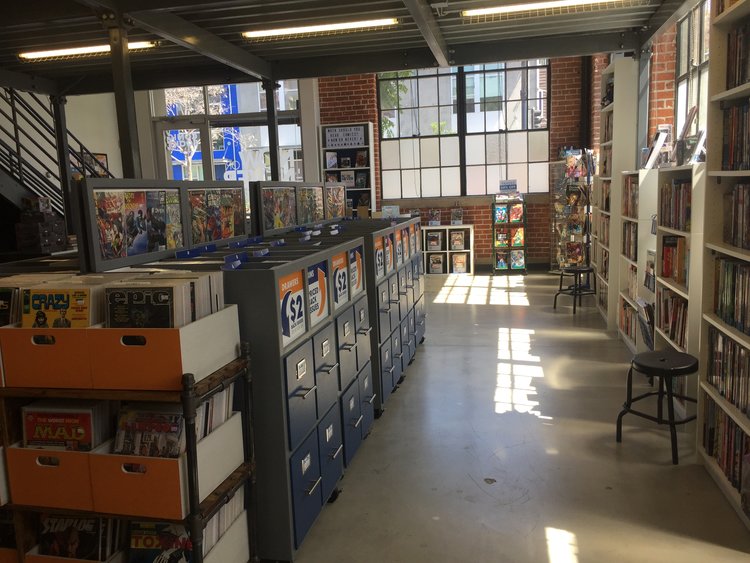
While the public handwringing from people who aren’t in the direct market gets very little credence, retailers do have sympathy for the perspectives of their peers.
“I think that every retailer complains about something that is important to them. It’s easy to dismiss things like ‘Oh, there’s Jim complaining about how staples aren’t done properly anymore, that’s ridiculous,’” Batista said. “But Jim is coming from a place where that simple fact is costing him sales.”
While the healthier approach might be to focus on your own world and come up with solutions rather than more problems, that isn’t always easy to do, especially for those who remember a time when the market was at least believed to be more collaborative. It can be cathartic and occasionally productive to make your voice heard. But Haines, who doubles as the President of ComicsPRO, 10 believes this conversation can be harmful, and that the constant emphasis of the negative can poison the well for everyone involved.
“To be perfectly honest, I think the biggest problem facing retail right now is the seeming proliferation of individual retailers who either cannot or will not see beyond what is happening within their own walls, and instead project their struggles onto the rest of the industry as if their store’s data is the same as everyone else’s,” Haines said. “The extreme negativity we are hearing from these people, who are claiming the ‘death of comics’ and such, is absolutely exhausting and counterproductive, and drives the positive voices away.”
Retailers aren’t the only ones who have a varied perspective on this moment. Customer sentiment is all over the place. Shops told me that regulars are everything from “positive” or “happy to buy comics” to “going through the motions” or even “despondent.” Several reported seeing plenty of changes in customer habits, even ones they considered positive overall, with some no longer buying out of obligation, instead leaning into the things they enjoy.
Of course, those shifts in customer behavior can come with a substantial cost for shops. Batista said one regular at Big Bang is a long-time reader, someone who has always bought “a lot of comics and multiple covers of the same book at times.” This person has been “dropping comics left and right” due to frustrations about the quality of what they were reading, both in terms of paper stock and the work itself.
“This is a customer that at one stage was buying over 60 single issues a week, and now barely cracks 25,” Batista said.
Now, while one could argue that this person likely has a healthier relationship with the medium now than before, it’s undeniable that publisher decisions have impacted this customer’s experience and the fortunes of Big Bang itself. Others reported similar drop-offs. Multiply that times a couple thousand shops and you have a real problem, and that’s just one type of customer. Regaining traction with that audience could lead to 2024 being much better for shops than 2023.
The good news is, the new year is starting strong. Merkler reported that some customers who were unenthusiastic about 2023’s slate are much more excited to dig into upcoming launches like Image’s Ghost Machine imprint and DC’s Elseworlds revival. More than that, the year may already have its first big hit, with many raving about Ultimate Spider-Man #1’s sales. Higgins said the recent Marvel launch “had more customers coming in or calling (about it) than I’ve seen on a book in a while.” He wasn’t the only one.
While enthusiasm amongst customers might be variable, the retailers I spoke to are cautiously optimistic about the upcoming year. Sometimes that’s for personal reasons, like King, who is incredibly excited to open her new shop, something she described as a “dream set up.” Other times it’s out of genuine belief in the year’s potential fortunes or the stories themselves. As Anderson said, “It’s just about keeping a healthy perspective on things and remembering what made us all fall in love with selling comics to begin with: the impact of a great story.”
That might come across as all talk, showy optimism in the face of the perilous struggles the direct market is up against. But as Higgins emphasized, comic retailers are a resilient bunch, and a group that has made it through plenty of challenges over the years.
“I’m always bullish on comic shops. We’re nimble and agile and can always adapt and even thrive in bad times,” Higgins said. “Anyone that’s writing off the industry hasn’t looked at the last 100 years of how comics have remained successful, through literal wars, economic crises, and global pandemics.”
And yet, there is a constant desire to write the direct market’s obituary, with outsiders endlessly declaring that the end is nigh. That belief may even be understandable right now, at least to some degree. Shops are facing real challenges. And it doesn’t help that there’s no data to back anything up. Even ignoring the lack of sales charts, no one really knows how things are going in an industry-wide sense. That’s why ComicsPRO will be “rolling out a comprehensive survey asking stores to provide crucial information to help ascertain the actual state of the industry” this month, per Haines. That data will act as a guide for the next year, which is why she’s hopeful shops will complete the survey.
Regardless of that survey’s results, Haines believes the direct market is “in a state of flux and will remain as such for probably a few more years.” To make it through a stretch like this, it’s the veteran retailer’s belief that everyone must “choose to adapt to new situations and find ways to work with what we’ve got.”
Maybe that’s why collaboration seems to be such a focus these days, even with previously unlikely dance partners. Schatz said a current project focused on metadata has “united publishers in a way that I don’t think has quite happened before.” That’s a major change from how they have been perceived of late. But when faced with challenges, people become more willing to try new things — even teaming up. As Haines emphasized, in a time like this, “There’s no moving backward.”
“It is only by working together as an industry that we are going to move things forward.”
Thanks for reading this feature on the year in comics retail. If you enjoyed what you read, consider subscribing to SKTCHD to support the work and to read more features, interviews, and columns like it.
The side of the comic industry comprised of comic shops.↩
Which won this year’s Eisner Award for comics retail, a point Manhoff was understandably gleeful about. In response to my question about the most positive part of his shop’s year, he exclaimed, “We won the motherfreaking Eisner, baby!”↩
And the world, really.↩
Meaning issues that are important for one reason or another, many of which relate to first appearances of characters or titles that somehow connect to potential adaptations.↩
But up from 2019.↩
This was a strategic closure, though, not one due to its struggles.↩
G.O.D.S. #1, the Energon Universe, Vault’s free #1 approach, and DSTLRY’s launch.↩
i.e. The past two years at Twitter/X.↩
A good example of this comes from Higgins, who said that 30% of Comics Conspiracy’s “sales dip can be attributed to just three customers” disappearing, with “almost all their purchases” being variant covers.↩
A trade organization for comic retailers.↩

